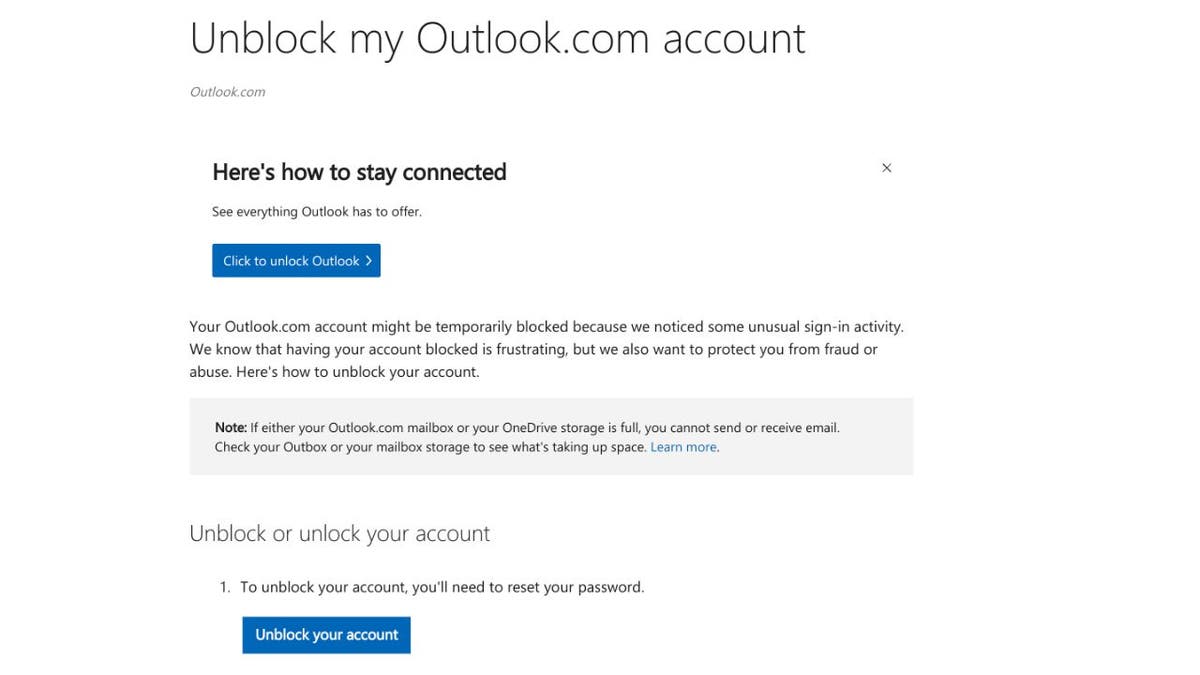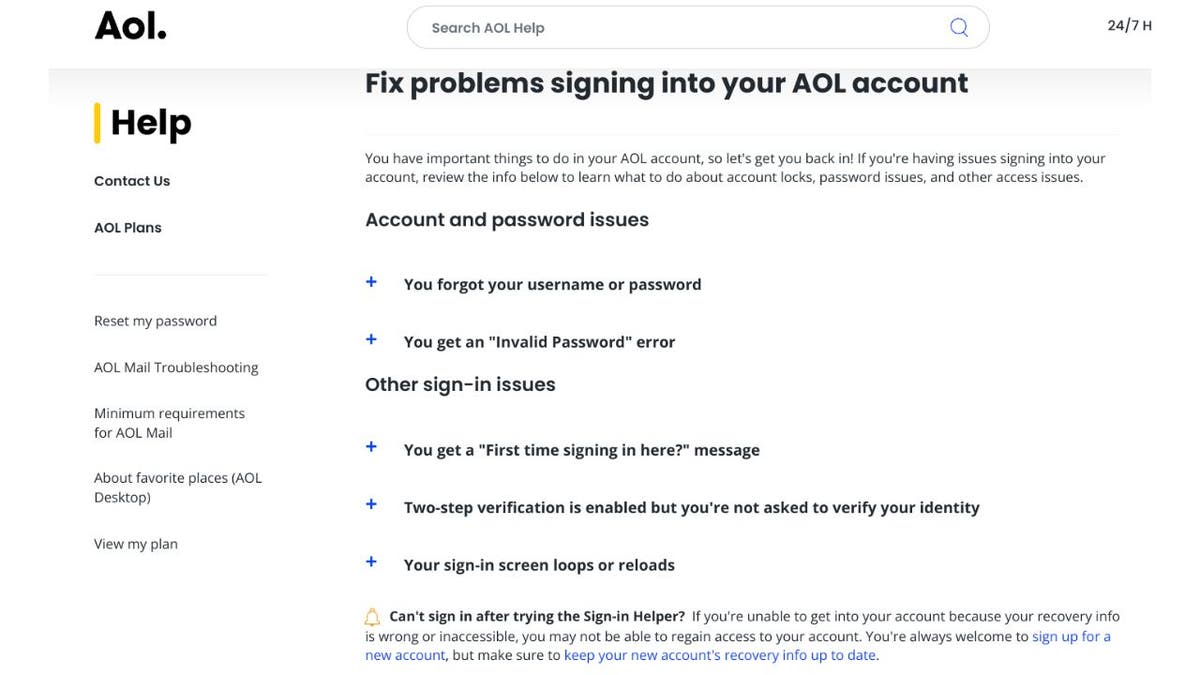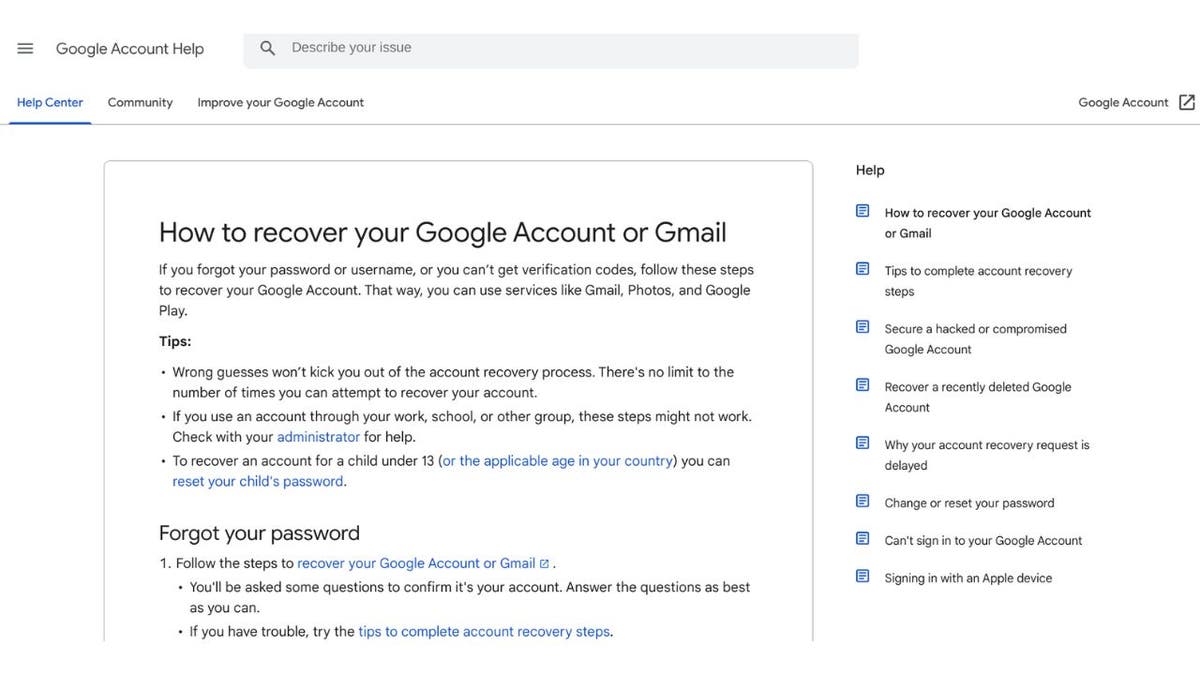A software engineer who was fired from Google in connection to internal protests at the company’s offices says the company retaliated against him for merely watching the demonstration against an Israeli defense contract.
Technology
Nationwide alert: SMS phishing attacks target toll road customers

The FBI has issued a critical warning about a pervasive scam sweeping across the country.
Americans are being targeted by a sophisticated series of SMS phishing — or “smishing” — attacks that bait them with fictitious unpaid road toll charges.
Toll road scam text. (FBI)
A surge of fraudulent activity
The smishing scheme has been active since last month, duping thousands of people, as reported by victims to federal authorities.
The FBI’s Internet Crime Complaint Center has documented a significant influx of over 2,000 complaints detailing deceptive texts that impersonate road toll services from various states.
CLICK TO GET KURT’S FREE CYBERGUY NEWSLETTER WITH SECURITY ALERTS, QUICK VIDEO TIPS, TECH REVIEWS AND EASY HOW-TO’S TO MAKE YOU SMARTER

Man texting on his phone. (Kurt “CyberGuy” Knutsson)
MORE: IS THE FTC CALLING YOU? PROBABLY NOT. HERE’S HOW TO AVOID A NEW PHONE SCAM TARGETING YOU
Mechanism of the road toll scam
Investigations reveal that these messages are uniform in their deception, falsely asserting that the recipient is delinquent on road toll payments. These communications aim to manipulate individuals into clicking on links that are ingeniously designed to mimic legitimate state toll service websites, complete with fluctuating phone numbers to elude detection.
HIGH SCHOOL STUDENTS, PARENTS WARNED ABOUT DEEPFAKE NUDE PHOTO THREAT

Woman texting on her phone. (Kurt “CyberGuy” Knutsson)
MORE: THE DARK WORLD OF FACEBOOK ADS WHERE SCAMMERS ARE TRYING TO STEAL YOUR MONEY
Regional responses to the threat
The Pennsylvania Turnpike has been at the forefront of the afflicted services, proactively advising its customers to avoid interacting with these fraudulent messages. Similarly, the Pennsylvania State Police have expressed their concern, highlighting that the scam texts redirect to counterfeit websites designed to steal personal data.

Pennsylvania toll road scam text. (Kurt “CyberGuy” Knutsson)
Expanding the watch
Regional services are not the only ones affected. E-ZPass customers who use the toll service across various parts of the U.S. have been under threat since the onset of these attacks. While this detail is not directly mentioned in the FBI’s public service announcement, secondary sources tracking the issue have confirmed it.
MORE: ‘UNSUBSCRIBE’ EMAIL SCAM IS TARGETING AMERICANS
Guidance if you receive a toll scam text message
The FBI has recommended several preventive measures in light of the ongoing phishing attacks.
1. Report the phishing attempt at ic3.gov with the scammer’s contact details and the website URL from the message.
2. Verify your toll account through the official service website.
3. Reach out to the official customer service for the toll service.
4. Erase the fraudulent text message from your device.
5. Use good antivirus protection on all devices to reduce risks. The best way to protect yourself from clicking malicious links that install malware that may get access to your private information is to have antivirus protection installed on all your devices. This can also alert you of any phishing emails or ransomware scams. Get my picks for the best 2024 antivirus protection winners for your Windows, Mac, Android & iOS devices.
If you click one of these toll scam links
For individuals who have engaged in these phishing attempts, it is crucial to take immediate action to secure personal and financial information. The FBI stresses the importance of monitoring for unfamiliar charges and disputing them promptly to mitigate any potential financial harm.
Kurt’s key takeaways
As the threat landscape evolves, staying informed about these scams is paramount. By following the FBI’s advisories and maintaining a high level of skepticism toward unsolicited texts claiming to be from toll services, you can safeguard against these invasive phishing tactics. It’s really important that we all work together to spot and call out scams. By doing this, we’re joining forces to protect people from cybercriminals who try to trick them.
What role should mobile carriers and tech companies play in combating smishing scams, and how can they improve their current measures? Let us know by writing us at Cyberguy.com/Contact.
For more of my tech tips & security alerts, subscribe to my free CyberGuy Report Newsletter by heading to Cyberguy.com/Newsletter.
Ask Kurt a question or let us know what stories you’d like us to cover.
Answers to the most-asked CyberGuy questions:
Copyright 2024 CyberGuy.com. All rights reserved.

Technology
Google worker fired over protest says he wasn’t even protesting
/cdn.vox-cdn.com/uploads/chorus_asset/file/24016883/STK093_Google_06.jpg)
The former employee, who asked to remain anonymous, said he went to the lounge on the 10th floor of Google’s New York City office around lunchtime to check out the protest.
“When I got there, there were probably 20-ish people sitting on the floor. I didn’t talk to any of them, I talked to folks who were standing up, passing out flyers, doing other roles,” he said, adding that the protesters were wearing matching T-shirts.
The worker then went back to his desk before returning to the protest around 5PM. “I chatted with them for maybe four minutes, like, ‘Oh my gosh, you’re still sitting here! How’s it going?’” he said. Then, he finished the workday from a nearby couch. The worker says he returned to Google the following day without incident. That night, while at dinner, he got an email from Google saying he had been terminated.
“I think it’s all part of this bigger context of Google cracking down on workers having a voice,” said the former employee, who worked at Google for almost three years and was part of the Alphabet Workers Union leadership. (The Alphabet Workers Union is a non-contract union, meaning it hasn’t been recognized by the NLRB.)
Google initially put nine employees on administrative leave for occupying its offices in New York City and Sunnyvale, California, in protest of Project Nimbus, a $1.2 billion cloud computing contract with the Israeli government. Those workers were also arrested. The company then fired 28 employees in connection with the protests. In an internal memo to staff, Chris Rackow, Google’s head of global security, said the company would take further action if needed.
“The overwhelming majority of our employees do the right thing,” Rackow’s statement read. “If you’re one of the few who are tempted to think we’re going to overlook conduct that violates our policies, think again. The company takes this extremely seriously, and we will continue to apply our longstanding policies to take action against disruptive behavior — up to and including termination.”
Less than a week later, Google fired more than 20 other employees, some of whom said they hadn’t participated in the protests at all.
In a statement to The Verge, Google spokesperson Bailey Tomson said the company investigated the “physical disruption inside our buildings on April 16, looking at additional details provided by coworkers who were physically disrupted” to determine which workers had been involved.”
But the software engineer who was fired says he was never contacted by HR or asked whether he had actually been involved in the protests. “They didn’t even reach out to me,” he said. “This was a total shock; I had no hint that this was coming.”
The software engineer who was fired says he was never contacted by HR or asked whether he had actually been involved in the protests
The worker said that while he was watching the protest, a security guard approached him and others in the lounge and asked to see their Google badges to make sure there were no outside participants. “It didn’t even occur to me that I shouldn’t show him my badge. He’s the security guard in the place that I work, and I was doing nothing wrong,” the worker said.
More than 50 workers who were fired by Google in connection with protests over the company’s ties to the Israeli government filed a complaint with the National Labor Relations Board on Monday. The workers have alleged unlawful retaliation and are asking for their jobs back, according to an emailed statement from No Tech For Apartheid, the group that organized the protests.
Google “retaliated against approximately 50 employees and interfered with their Section 7 rights by terminating and/or placing them on administrative leave in response to their protected concerted activity, namely, participation (or perceived participation) in a peaceful, non-disruptive protest that was directly and explicitly connected to their terms and conditions of work,” the complaint reads.
Jane Chung, a spokesperson for No Tech For Apartheid, previously told The Verge that the firings included “non-participating bystanders.” Google disputes this. Tomson, the Google spokesperson, told The Verge that all of the workers who were fired were “personally and definitively involved in disruptive activity inside our buildings.”
This is a marked departure from the way Google has handled employee dissent in the past. In 2018, more than 600 Google workers signed an open letter opposing Project Dragonfly, an effort to build a search engine for China. As The Verge reported at the time, the petition began with an internally shared Google Doc, and all subsequent steps were also organized using Google products. Employees also urged Google to drop Project Maven, its contract with the US Department of Defense. That same year, over 20,000 Google employees staged a walkout in protest of the company’s handling of sexual harassment allegations against executives.
Meredith Whittaker, a program manager at Google who helped organize the 2018 walkout, left the company in 2019 of her own volition. In 2019, workers also held a sit-in protesting alleged retaliation against their colleagues who had spoken out.
“There’s been a total change in the way Google responds to employees trying to have a voice in their workplace,” the fired software engineer said. “It’s night and day from the Google of even five, 10 years ago.”
Technology
Never get locked out of your email again by doing this

Getting locked out of your email is no fun. To start, maybe you forgot your username or password, and now you have to go through all the security verification steps to reset it. Or perhaps you thought you knew your information, but with too many attempts, you’ve been locked out of your account entirely. This could also happen if someone else attempted to log in to your account with a similar username to yours and, with all their incorrect attempts, accidentally locked you out in the process.
Even if you have account recovery information on file, sometimes it’s not enough. Maybe the recovery information you have on a file is with an old email or one you don’t remember the login information for. We’ve all been there.
Whatever the case, getting back into your account depends on why you can’t access it in the first place. Many of us rely on our email daily – whether to stay in touch with friends or family, receive newsletters or handle essential documents and correspondence – so it’s important to know what to do if you ever get locked out of your email.
CLICK TO GET KURT’S FREE CYBERGUY NEWSLETTER WITH SECURITY ALERTS, QUICK VIDEO TIPS, TECH REVIEWS AND EASY HOW-TO’S TO MAKE YOU SMARTER
Person typing on laptop (Kurt “CyberGuy” Knutsson)
How to get back into your email account on:
Outlook

How to unlock Outlook page (Microsoft) (Kurt “CyberGuy” Knutsson)
Go to the sign-in page: Visit the Outlook.com sign-in page and click “Forgot my password.”
- Verify your identity: Choose why you need your password reset and then continue. For security purposes, you’ll be asked to enter your email address and the characters you see on the screen.
- Receive a security code: Choose how you want to get the security code (usually via an alternate email or SMS). Enter the code you receive to verify your identity.
- Reset your password: Create a new password once your identity is confirmed.
If your account gets blocked, you can also visit their account recovery help here.
MORE: BEST PRIVATE AND SECURE EMAIL PROVIDERS 2024
AOL

Fix problems signing into your AOL account page (AOL) (Kurt “CyberGuy” Knutsson)
Access the AOL sign-in page: Navigate to the AOL sign-in page and click “Forgot password?”
- Verify information: Provide the email address or phone number linked to your account and follow the on-screen instructions.
- Choose how to reset your password: You’ll receive options for resetting your password, including receiving a verification code via email or SMS.
- Reset the password: Enter the verification code received and create a new password.
If you’re still locked out of your account, visit AOL’s help page here.
DuckDuckGo Email

DuckDuckGo email support page (DuckDuckGo) (Kurt “CyberGuy” Knutsson)
DuckDuckGo provides email forwarding services through @duck.com addresses linked to your primary email. Here are the steps if you’re locked out.
- Access DuckDuckGo settings: Since DuckDuckGo email is not a full-fledged email provider but a forwarding service, you’ll need to access your DuckDuckGo settings through their website.
- Manage your Email Protection: In the settings, navigate to Email Protection and verify your identity as needed.
- Check linked email: Ensure your primary email address is correct and has access. If not, follow the recovery process for your primary email provider.
If you have trouble logging in, DuckDuckGo recommends contacting their support team at support@duck.com. You can read more about it on their help pages.
MORE: UNFORGETTABLE MOTHER’S DAY GIFTS 2024
Yahoo

Fix problems signing into your Yahoo account page (Yahoo) (Kurt “CyberGuy” Knutsson)
Visit the Help site: Go to the Yahoo sign-in helper page.
- Enter your Yahoo ID: Input your Yahoo email address and continue. You may also be asked to enter the CAPTCHA code. Then click “Forgot Password?”
- Choose your recovery method: You can choose to receive a verification code via email or text message to a registered alternate email address or phone number.
- Enter the verification code: Type the verification code you received to verify your identity.
- Create a new password: After verification, you will be prompted to create a new password.
MORE: 5 WAYS TO MAKE YOUR FACEBOOK ACCOUNT BULLETPROOF
StartMail

I forgot my password page (StartMail) (Kurt “CyberGuy” Knutsson)
- Visit the recovery page: Go to the StartMail log-in page and click on “Forgot your password?”.
- Enter your account details: Provide your StartMail account email address.
- Verification via backup email: You’ll receive an email with instructions to reset your password at your backup email address.
- Reset your password: Follow the instructions in the email to reset your password.
StartMail uses a recovery email or a one-time verification code if you get locked out. This will have to be set up when you first open the account. For additional support for each one of these steps, visit here.
Gmail

How to recover your Google Gmail page (Gmail) (Kurt “CyberGuy” Knutsson)
Visit Account Recovery: Go to the Google Account Recovery page at https://accounts.google.com/signin/recovery.
- Enter your Gmail address: Input the email address you need to access. Click “Next.”
- Verify your identity: You’ll be prompted with several ways to verify your identity. Choose the most convenient option, which might include answering security questions, receiving a verification code via text or a phone call to a previously configured recovery phone number, or sending a verification code to a recovery email address you had set up.
- Receive and enter the verification code: If you opt to receive a code, enter it in the provided space to proceed.
- Reset your password: Once verified, you can set a new password. Choose a strong and secure password that hasn’t been used on your account before.
- Recovery without sufficient information: If you can’t provide enough information to verify your account immediately, keep trying. Google might offer additional questions or options after several attempts or after some time has passed.
- Follow additional instructions: If you successfully verify your identity, follow any further instructions from Google to regain access to your account.
The nice thing about Gmail is that you have unlimited attempts. They won’t lock you out, so you can continue to try. If you need additional help, visit their account recovery help page here.
MORE: HOW A FLAW IN IPHONE’S SECURITY COULD LEAVE YOU LOCKED OUT
Kurt’s key takeaways
We’ve all been locked out of our accounts at one point or another. Luckily, most email platforms make it relatively simple to get back in, with security at the top of mind. That being said, storing your usernames and passwords somewhere safe (the old pen-and-paper method does the trick) so you don’t risk getting locked out. Of course, be sure to use secure password best practices whenever you can.
Have you ever been locked out of one of your email accounts to the point where you had to create a new account altogether? Let us know by writing us at Cyberguy.com/Contact.
For more of my tech tips and security alerts, subscribe to my free CyberGuy Report Newsletter by heading to Cyberguy.com/Newsletter.
Ask Kurt a question or let us know what stories you’d like us to cover.
Answers to the most asked CyberGuy questions:
Copyright 2024 CyberGuy.com. All rights reserved.
Technology
Automatic emergency braking at speeds up to 90mph required under new rule
/cdn.vox-cdn.com/uploads/chorus_asset/file/25426860/2147863367.jpg)
The US Department of Transportation finalized a new Federal Motor Vehicle Safety Standard requiring all vehicle manufacturers to include automatic emergency braking in their light-duty vehicles (basically all passenger vehicles, including SUVs and pickup trucks) by 2029. The new rule aims to prevent hundreds of deaths and tens of thousands of injuries every year. The Department of Transportation is also in the process of finalizing a similar rule for heavy-duty vehicles weighing over 10,000 pounds.
Around 90 percent of light-duty vehicles on the road today come standard with automatic emergency braking, or AEB. But the new rule requires automakers to adopt a more robust version of the technology that can stop vehicles traveling at higher speeds and detect vulnerable road users, like cyclists and pedestrians, even at night.
The new rule requires automakers to adopt a more robust version of the technology
According to the Department of Transportation, all cars are now required to be able to “stop and avoid contact with a vehicle in front of them up to 62 miles per hour and that the systems must detect pedestrians in both daylight and darkness.” Also, AEB systems must apply the brakes automatically “up to 90 mph when a collision with a lead vehicle is imminent, and up to 45 mph when a pedestrian is detected.”
Under the new rule, automakers would be required to beef up their current AEB systems, which research has shown to be decent at preventing low-speed rear-end crashes but less effective when vehicles are traveling at fast but still average speeds. The American Automobile Association (AAA) has been testing AEB systems for years and found a variety of common scenarios in which the braking technology completely fails to do the job as advertised.
The new standard comes amid a modest decline in traffic deaths, which spiked during the pandemic. The National Highway Traffic Safety Administration said that 42,514 people died in crashes in 2023, down 3.6 percent from the year before. It was the third year in a row in which more than 40,000 people died in traffic crashes.
-

 Education1 week ago
Education1 week agoVideo: Dozens of Yale Students Arrested as Campus Protests Spread
-

 World1 week ago
World1 week agoEU sanctions extremist Israeli settlers over violence in the West Bank
-

 World1 week ago
World1 week agoShipping firms plead for UN help amid escalating Middle East conflict
-

 Politics1 week ago
Politics1 week ago'Nothing more backwards' than US funding Ukraine border security but not our own, conservatives say
-

 Politics1 week ago
Politics1 week agoDemocrats hold major 2024 advantage as House Republicans face further chaos, division
-

 World1 week ago
World1 week agoPeriod poverty still a problem within the EU despite tax breaks
-

 Politics1 week ago
Politics1 week agoFetterman hammers 'a–hole' anti-Israel protesters, slams own party for response to Iranian attack: 'Crazy'
-

 Politics1 week ago
Politics1 week agoA battle over 100 words: Judge tentatively siding with California AG over students' gender identification















